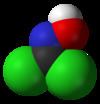Formula Cl2C=NOH Boiling point 128 °C | Molar mass 113.93 g/mol | |
 | ||
Appearance colorless crystalline solid or yellowish-brown liquid | ||
Phosgene oxime, or CX, is an organic compound with the formula Cl2CNOH. It is a potent chemical weapon, specifically a nettle agent. The compound itself is a colorless solid, but impure samples are often yellowish liquids. It has a strong, disagreeable odor and a violently irritating vapor.
Contents
Preparation and reactions
Phosgene oxime can be prepared by reduction of chloropicrin:
Cl3CNO2 + 2 Sn + 5 HCl + H2O → Cl2C=N−OH + 2 H3O[SnCl3]The observation of a transient violet color in the reaction suggests intermediate formation of trichloronitrosomethane (Cl3CNO). Early preparations, using stannous chloride as the reductant, also started with chloropicrin.
The compound is electrophilic and thus sensitive to nucleophiles, including base hydrolysis:
Cl2CNOH + 2 NaOH → CO2 + NH2OH + 2 NaCl + H2OSimilar processes provide an easy way to destroy this dangerous compound. Hydrazine converts it to HCN and N2.
Safety
Phosgene oxime is classified as a vesicant even though it does not produce blisters. It is toxic by inhalation, ingestion, or skin contact. The effects of the poisoning occur almost immediately. No antidote for phosgene oxime poisoning is known. Generally, any treatment is supportive. Typical physical symptoms of CX exposure are as follows:
Decontamination, treatment, and handling properties
Phosgene oxime is highly soluble in water. It is corrosive to metals and also decomposes on contact with metals. It is rapidly hydrolysed by alkaline solutions. Adsorbent powders such as Fuller's earth or talcum powder can also be used.
